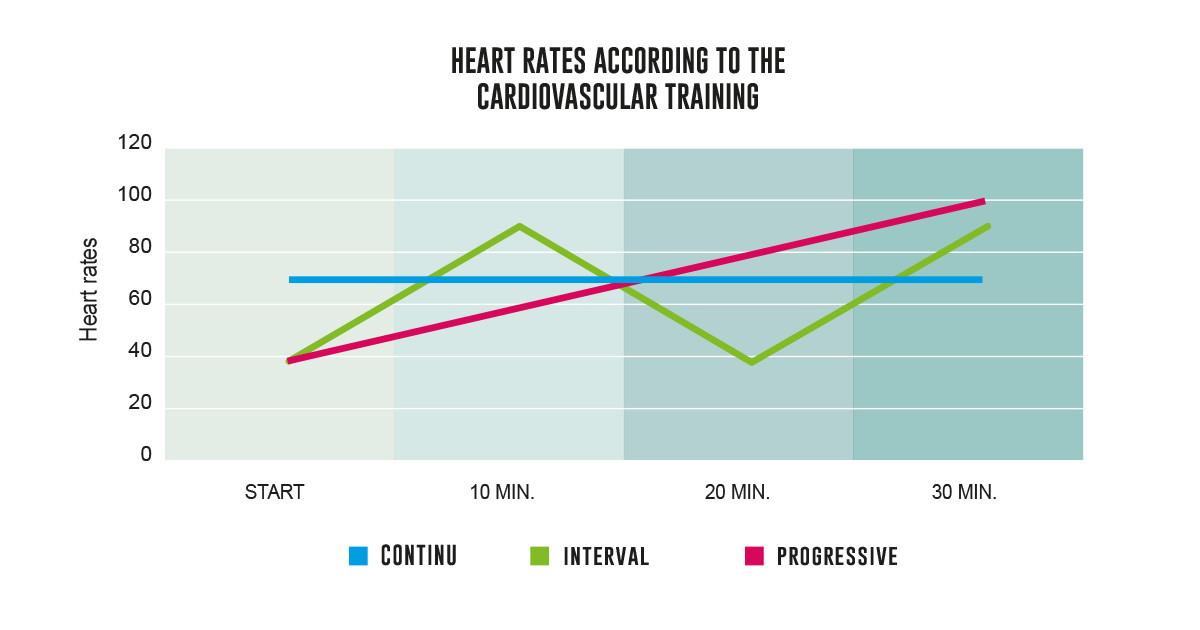CARDIO: AT THE HEART OF TRAINING

No pun intended, cardiovascular workout is at the heart of training. Most exercises are simple and accessible to the vast majority of the population. Find the right one for you and it may win your heart – pun intended.
CARDIOVASCULAR TRAINING
The idea of cardiovascular training is not very complicated to most people. However, it is important to properly understand the different types of cardiovascular training and their benefits. That said, a good unit of measure is your heart rate.
Whether you choose to do your training on a bike, by running or by doing weight training (such as box jumps), Studiogym will guide you in your process.
There are 3 main categories of cardiovascular training: continuous, interval and progressive training.
CONTINUOUS TRAINING
Continuous training is highly recommended for a beginner, but also for a person wanting to improve their muscular endurance. In fact, the goal is to try to keep your heart rate (HR) at around 70% of your maximum capacity (HRMax) throughout the training period. It is recommended to do at least 10 minutes of continuous training to feel the benefits. Moreover, it is scientifically recognized that intramuscular triglycerides act as the main source of energy during training that use 65% of VO2 max *. This means that this type of training reduces the body fat percentage. However, continuous training seems to have little impact on cardiovascular improvement. Furthermore, this type of training is also difficult to apply to muscle training because heart rates may vary.
INTERVAL TRAINING
Interval training consists of bursts of high-intensity training for a period of time, followed by periods of rest. Intense periods of up to 95% intensity are followed by rest periods of around 40% intensity. This type of training represents the real world situation of many athletes such as the hockey or soccer player. There is a wide variety of interval training out there, and it is not only available to runners or cyclists.
HIIT training, for example, is a workout that you can do to also build muscle strength. Interval training has a great influence on heart development, resulting in improved cardiovascular capacity *.
PROGRESSIVE TRAINING
Progressive training rests on the principle that heart rates should gradually increase to reach the maximum heart rate. This type of training is very similar to a maximal effort test such as the shuttle test or the yoyo test. For example, using a treadmill, you set the starting speed to 7km/hour, and you increase the speed by 1km every minute. It is also possible to reproduce this kind of training using compound exercises in a circuit training workout. Progressive training also improves cardiovascular capabilities as participants reach their maximum heart rates.
Studiogym has constructed a graph that allows you to better visualize the target heart rates according to the chosen cardiovascular training. You will notice that continuous training corresponds to a line demonstrating a constant, while the interval training looks a little like a rollercoaster. Progressive training is also a constant line, but it gradually increases towards the maximum heart rate.

Edward F. Coyle. Sports science exchange. Metabolisme des graisse pendant l’exercice. SSE N59. Volume 8 Numéro 5. 1995
Astorino, TA, Allen RP, Roberson, DW, Jurancich M. Effect of high-intensity training on cardiovascular function,VO2 max , and muscular force. J Strength Cond Res. 2012 Jan;26(1):138-45. doi: 10.1519/JSC.0b013e318218dd77.
